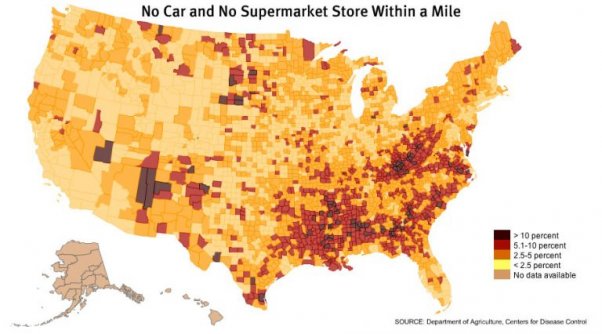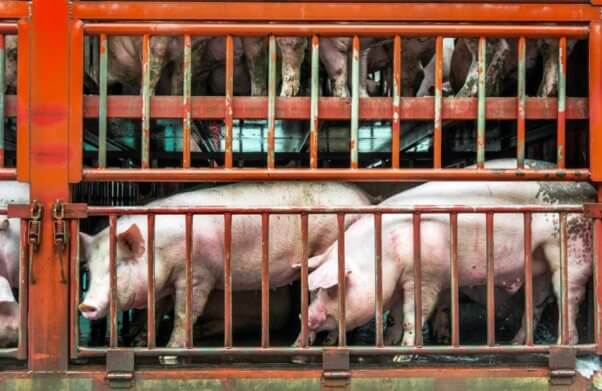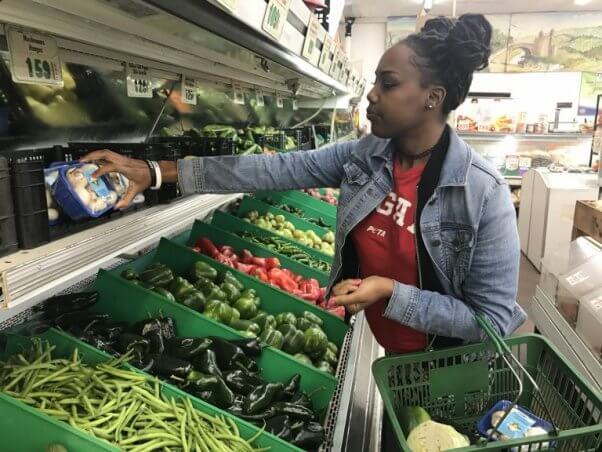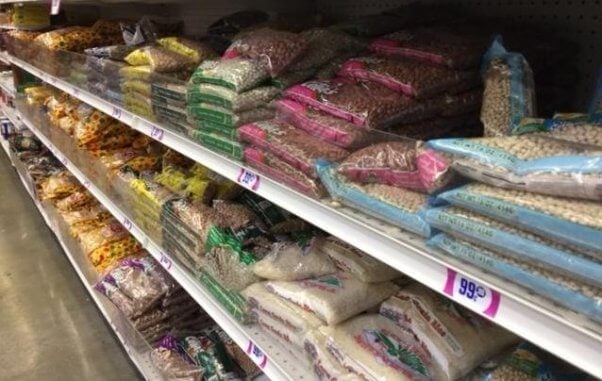Not everyone grows up within walking distance of a health-food store. And some of us grew up outside driving distance to a store with fresh veggies or fruit, too. Areas like these are known as “food deserts”: The closest thing that some people have to a grocery store is a liquor store.

Areas where healthy, fresh food is hard to find usually disproportionately affect African-American communities and low-income neighborhoods. People living in these areas are locked into the system of food injustice, because having to resort to processed meats and snacks puts them at higher risk of suffering from diabetes, heart disease, cancer, and strokes.

Who Profits From This?
We talk a lot about the power of your dollar as a consumer, because voting with your purchasing choices works: The more that people demand vegan foods, the more that companies will meet that demand with a tasty supply. Food deserts and fast-food restaurants are forced onto poor people, who have less purchasing power. Who profits? The meat and dairy industries and, once people get sick, Big Pharma.
Why Does This Matter to Animals?
While humans are getting sick from eating animal flesh and processed foods, billions of animals are forced to live on filthy factory farms, before being violently killed, chopped up, and sold as food. The bottom line is that eating meat is completely unnecessary, and it harms both humans and animals.

Everyone can be vegan—even in a neighborhood that makes it tough. Here are seven ways to thrive in a food desert:
1. Get familiar with staples. Many convenience stores and corner markets sell things like pasta, pasta sauce, and sometimes even frozen veggies. If you live near a dollar store, you might be surprised by just how much you can find there on a budget. Beans, rice, tortillas, salsas, and more can be found at nearly every dollar store. Here’s a list of delicious vegan recipes you can make for under $3.
2. Look up programs that offer healthy food aid. There are several programs that help provide access to fresh foods. For example, people enrolled in the Supplemental Nutrition Assistance Program (SNAP) can use their electronic benefit transfer cards to buy healthy foods at participating markets.
3. Visit your closest co-op or farmer’s market. Keep an eye out for places that sell fresh foods in your neighborhood, like co-ops or a local farmer’s market. A co-op is an organized food distribution outlet where the members get to pick what is sold. These are great places to buy fresh fruits and veggies. This might mean having to leave your neighborhood, but it’ll be worth it. If you have a smartphone, apps like HappyCow can help you find nearby vegan-friendly establishments.

4. Start an urban garden at home. Starting a garden indoors with limited space is easier than ever, thanks to the internet. Many channels on YouTube demonstrate how to plant and sustain a thriving urban garden in planters, on window ledges, on balconies, and so on. For example, there are specific instructions online for planting an herb garden using the pockets of a plastic shoe holder that hangs on the back of a door!
5. Buy beans and whole grains in bulk. When you spot beans and whole-grain items, grab them. They’re full of nutrients like protein and fiber, without the cholesterol and saturated fat found in meat. They’re affordable, too, and awesome in chili, tacos, and more.
6. Visit your local store and ask for more nutritious food options. Ask the manager to stock healthier vegan foods—like fresh fruits and veggies, healthy pasta sauces, and even vegan meats from brands such as Gardein. You might be surprised by what you can get your local store to carry if you just ask.

7. Public transportation can open new worlds. Live near a bus line? Take a day trip to find the closest Target or Walmart, or look for a health-food store near a local college campus. (Many accept SNAP.) Research ideas for nutritious meals that you can make at home, and stock up for the month.
Systemic oppression is nuanced and reinforced in many different ways, including through inequitable food systems. You can be a force for positive change in your community by demanding better conditions for humans and animals. If you have to eat fast food once in a while for its cost efficiency, please visit our helpful guide to ordering vegan at fast-food chains.







